Clathrin-Mediated Albumin Clearance in Alveolar Epithelial Cells of Murine Precision-Cut Lung Slices
- PMID: 36768968
- PMCID: PMC9916738
- DOI: 10.3390/ijms24032644
Clathrin-Mediated Albumin Clearance in Alveolar Epithelial Cells of Murine Precision-Cut Lung Slices
Abstract
A hallmark of acute respiratory distress syndrome (ARDS) is an accumulation of protein-rich alveolar edema that impairs gas exchange and leads to worse outcomes. Thus, understanding the mechanisms of alveolar albumin clearance is of high clinical relevance. Here, we investigated the mechanisms of the cellular albumin uptake in a three-dimensional culture of precision-cut lung slices (PCLS). We found that up to 60% of PCLS cells incorporated labeled albumin in a time- and concentration-dependent manner, whereas virtually no uptake of labeled dextran was observed. Of note, at a low temperature (4 °C), saturating albumin receptors with unlabeled albumin and an inhibition of clathrin-mediated endocytosis markedly decreased the endocytic uptake of the labeled protein, implicating a receptor-driven internalization process. Importantly, uptake rates of albumin were comparable in alveolar epithelial type I (ATI) and type II (ATII) cells, as assessed in PCLS from a SftpcCreERT2/+: tdTomatoflox/flox mouse strain (defined as EpCAM+CD31-CD45-tdTomatoSPC-T1α+ for ATI and EpCAM+CD31-CD45-tdTomatoSPC+T1α- for ATII cells). Once internalized, albumin was found in the early and recycling endosomes of the alveolar epithelium as well as in endothelial, mesenchymal, and hematopoietic cell populations, which might indicate transcytosis of the protein. In summary, we characterize albumin uptake in alveolar epithelial cells in the complex setting of PCLS. These findings may open new possibilities for pulmonary drug delivery that may improve the outcomes for patients with respiratory failure.
Keywords: acute respiratory distress syndrome; albumin; alveolar epithelium; endocytosis; precision-cut lung slices; protein transport.
Conflict of interest statement
The authors declare no conflict of interest.
Figures
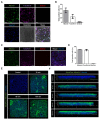
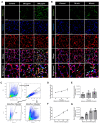
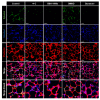
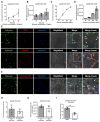

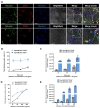
Similar articles
-
Influenza virus decreases albumin uptake and megalin expression in alveolar epithelial cells.Front Immunol. 2023 Sep 1;14:1260973. doi: 10.3389/fimmu.2023.1260973. eCollection 2023. Front Immunol. 2023. PMID: 37727782 Free PMC article.
-
Megalin mediates transepithelial albumin clearance from the alveolar space of intact rabbit lungs.J Physiol. 2012 Oct 15;590(20):5167-81. doi: 10.1113/jphysiol.2012.233403. Epub 2012 Jul 23. J Physiol. 2012. PMID: 22826129 Free PMC article.
-
Endocytic uptake of FITC-albumin by human alveolar epithelial cell line A549.Drug Metab Pharmacokinet. 2012;27(3):336-43. doi: 10.2133/dmpk.dmpk-11-rg-127. Epub 2012 Jan 3. Drug Metab Pharmacokinet. 2012. PMID: 22214936
-
Receptor-mediated endocytosis of macromolecules and strategy to enhance their transport in alveolar epithelial cells.Expert Opin Drug Deliv. 2015 May;12(5):813-25. doi: 10.1517/17425247.2015.992778. Epub 2014 Dec 12. Expert Opin Drug Deliv. 2015. PMID: 25496474 Review.
-
Mechanisms of alveolar protein clearance in the intact lung.Am J Physiol Lung Cell Mol Physiol. 2004 Apr;286(4):L679-89. doi: 10.1152/ajplung.00205.2003. Am J Physiol Lung Cell Mol Physiol. 2004. PMID: 15003932 Review.
Cited by
-
Precision cut lung slices: an integrated ex vivo model for studying lung physiology, pharmacology, disease pathogenesis and drug discovery.Respir Res. 2024 Jun 1;25(1):231. doi: 10.1186/s12931-024-02855-6. Respir Res. 2024. PMID: 38824592 Free PMC article. Review.
-
Alveolar-capillary endocytosis and trafficking in acute lung injury and acute respiratory distress syndrome.Front Immunol. 2024 Mar 12;15:1360370. doi: 10.3389/fimmu.2024.1360370. eCollection 2024. Front Immunol. 2024. PMID: 38533500 Free PMC article. Review.
-
Influenza virus decreases albumin uptake and megalin expression in alveolar epithelial cells.Front Immunol. 2023 Sep 1;14:1260973. doi: 10.3389/fimmu.2023.1260973. eCollection 2023. Front Immunol. 2023. PMID: 37727782 Free PMC article.
-
Serum Albumin in Health and Disease: From Comparative Biochemistry to Translational Medicine.Int J Mol Sci. 2023 Sep 6;24(18):13725. doi: 10.3390/ijms241813725. Int J Mol Sci. 2023. PMID: 37762028 Free PMC article.
-
Palindrome-mediated DNA nanotubes with cell-specific aptamers to improve targeted antitumor effects and reduce toxicity on non-small cell lung cancer.Sci China Life Sci. 2025 Feb;68(2):454-466. doi: 10.1007/s11427-023-2556-4. Epub 2024 Nov 26. Sci China Life Sci. 2025. PMID: 39609362
References
MeSH terms
Substances
Grants and funding
LinkOut - more resources
Full Text Sources
Research Materials
Miscellaneous

